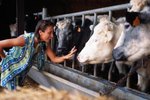Zebus belong to the Bos primigenius species of cattle. The name “zebu” is derived from the Tibetan word “ceba,” which means “hump.” They are one of the oldest breeds, originating in India and dating back to 3000 BC. These cattle have a large hump on their upper back, flabby skin under the chin called a dewlap and come in shades of gray and tan. In some countries, zebu meat is no stranger to the menu; however, India deems zebus sacred and only consumes the animals' milk.
Tropical Climate
The humped cattle are native to a very hot, tropical climate. Zebus have more efficient sweat glands to battle the heat, as well as a lower metabolism rate and smaller, more compact bodies. Because they are smaller in size than other cattle, zebus require fewer resources for survival, because a slower metabolism means they can go longer periods of time without food. There are also hump-less cattle throughout Africa that are considered to be a subspecies of the zebu. These animals have adapted to life without the hump and can survive without difficulty in a subtropical environment. Four million zebus exist worldwide, primarily in Asia and Africa, although they were introduced into Brazil in the 17th and 18th centuries and were first introduced into the United States, where they are known as Brahman cattle, in the 19th century.
Breeding
Domesticated cattle are classified as either zebu (Bos indicus) or European (Bos taurus). Over 70 species of zebu exist and are descendants of three non-humped breeds of Indian cattle: the Guzerat, Nelore and the Gir. The most distinguishing feature between the zebus and the European cattle is the hump of fat, connective tissue and muscle on the upper back. Zebus are highly resistant to parasites and disease, making them ideal candidates for breeding with other cattle.
In some tropical regions the native cattle are not easily be classified as Bos taurus or Bos indicus; rather, they have a combination of the features of the two groups. Sanga cattle of Southern Africa, are usually classified as zebu type. Their hump is less prominent than in zebu and is located at the back part of the neck. Other intermediate types are the Damietta (Egypt) and the Damascus cow (Syria).
Physiology of a Zebu's Hump
This characteristic fleshy mass is due mainly to enlargement of the rhomboideus muscles in the shoulder and back area. The hump consists of muscle, connective tissue and some fat. Vertebrae beneath and behind it are extended and branched or forked. The size and shape of the hump actually depends on the breed, sex and age of the individual animal, but its function is not clearly understood. The earlier assumption was that the hump served as a storage place for fat to be used during periods of low food supply. However, this theory has been rejected because it is chiefly an enlarged muscle rather than mostly fat. In any event, the male's hump is usually quite a bit bigger than the female's.
More on the hump
The zebu's hump contains numerous blood vessels that allow the animal to metabolize quickly. Some specimens even have two. The position of the hump on the animal’s back is also used to classify the zebu proper and zebu crossbred types into cervicothoracic-humped -- called Sanga -- and thoracic-humped stocks. However, as breeding continues, the characteristic hump begins to diminish. If one of its functions is to display his masculinity to other bulls and cows, this might affect reproduction.
References
Resources
Writer Bio
Kathleen March has been a writer for 40 years. A professor and translator of Spanish, Portuguese, and Galician, she has studied several languages and uses them for travel and research. She enjoys medieval architecture and avant-garde poetry. Her work has appeared in numerous critical journals in the U.S. and Spain.



